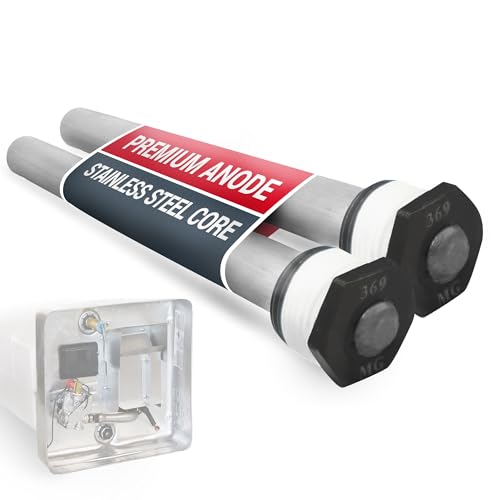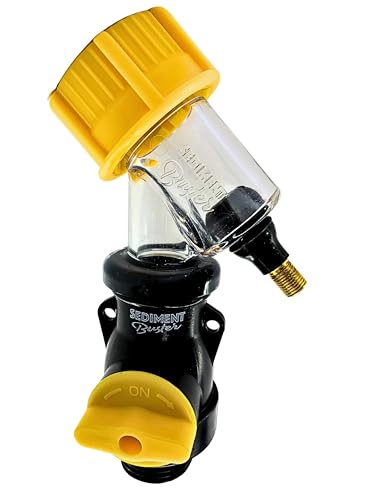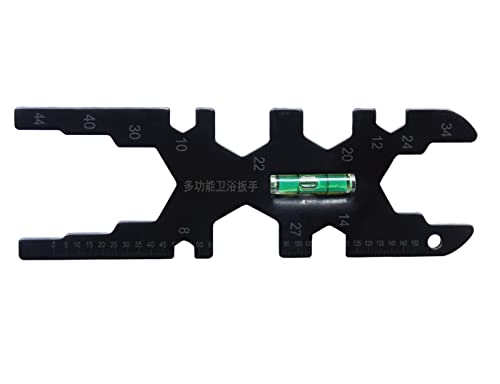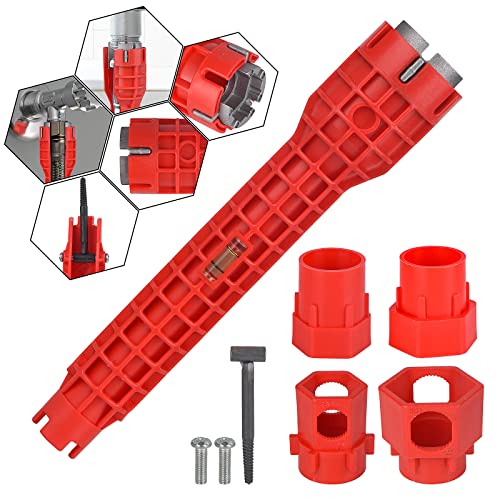You are using an out of date browser. It may not display this or other websites correctly.
You should upgrade or use an alternative browser.
You should upgrade or use an alternative browser.
PVC Leaks under sink (new install)
- Thread starter PaulinWI
- Start date

Help Support Plumbing Forums:
This site may earn a commission from merchant affiliate
links, including eBay, Amazon, and others.
Jeff Handy
Pro Handyman, NOT A Pro Plumber
The inner edge of the fitting at the wall looks beveled, so it seems to be a proper trap adapter.
Jeff Handy
Pro Handyman, NOT A Pro Plumber
There is no vent visible in the picture of the plumbing in the open stud wall.
Jeff Handy
Pro Handyman, NOT A Pro Plumber
Even with no vent, the sink should drain, just very chuggy and gluggy.
Run a snake down through the pipe in the wall.
All the way as far as the toilet.
Maybe someone stuck a rag in the future sink drain to keep sewer gases contained.
Run a snake down through the pipe in the wall.
All the way as far as the toilet.
Maybe someone stuck a rag in the future sink drain to keep sewer gases contained.
Jeff Handy
Pro Handyman, NOT A Pro Plumber
You also might want or need to add an air admittance valve, to help the sink to drain.
- Joined
- Sep 28, 2014
- Messages
- 8,578
- Reaction score
- 2,977

$32.98 ($5.50 / Count)
Membrane Solutions 5 Micron 10"x2.5" String Wound Whole House Water Filter Replacement Cartridge Universal Sediment Filters for Well Water - 6 Pack
Membrane Solutions Corp

$24.79 ($6.20 / Count)
$31.99 ($8.00 / Count)
1 Micron 2.5" x 10" Whole House CTO Carbon Water Filter Cartridge Replacement for Under Sink Water Filter System, Dupont WFPFC8002, WFPFC9001, FXWTC, SCWH-5, WHEF-WHWC, WHCF-WHWC, AMZN-SCWH-5, 4Pack
PUREPLUS FILTERS

$14.55
$16.99
Camco Aluminum Anode Rod- Extends the Life of Water Heaters by Attracting Corrosive Elements, Tank Corrosion Protection (11563)
The GENERAL Store

$345.00
3M Aqua-Pure Whole House Sanitary Quick Change Water Filter System AP903, Reduces Sediment, Chlorine Taste and Odor, Heavy Duty, 100,000 Gallon
Buying Direct Corp: Free & Fast Shipping

$45.56
$69.99
Rain Bird LNDDRIPKIT Drip Irrigation Landscape/Garden Watering Kit with Drippers, Micro-Bubblers, Micro-Sprays
Amazon.com

$27.19
$32.15
RIDGID 57003 EZ Change Plumbing Wrench Faucet Installation and Removal Tool
Amazon.com

$4.99 ($1.00 / Ounce)
Latwne Kitchen Repair Plumbing Tool Sink Faucet Key Plumbing Pipe Four-Claw Wrench Bathroom Wrench Tool Sets 4 Bayonet
ShiYanShiXiaoZhuoShangMaoYouXianGongSi

$42.56
$49.60
RIDGID 29983 Model 223S 1/4" to 1-1/4" Inner/Outer Copper and Stainless Steel Tubing and Pipe Reamer, Small
Amazon.com
Man, this is a common issue. Most DWV piping for sinks is 1.5" PVC. Many sinks used to come with matching 1.5" tail pieces and traps. Then--what a surprise--the manufacturers started using 1.25" tail pieces and traps. This requires what Frodo pointed out--it's an extra thick diameter compression washer to allow you to insert a 1.25" trap or pipe into a 1.5" waste pipe.
My experience with these is spotty; the washers come in varying thicknesses and quality and man they have to be REALLY TIGHT in order to work 100%. You can get them just tight, and you may get 99.5%, and that results in a drip--very slow sometimes, but a drip nonetheless.
My own opinion is things work better without these adapter compression washers. Tailpieces and traps in 1.5" to match the 1.5" DWV pipe...or, a different PVC adapter at the wall fitting that converts from 1.5" to 1.25" so you don't have to use the adapter compression washer...
My experience with these is spotty; the washers come in varying thicknesses and quality and man they have to be REALLY TIGHT in order to work 100%. You can get them just tight, and you may get 99.5%, and that results in a drip--very slow sometimes, but a drip nonetheless.
My own opinion is things work better without these adapter compression washers. Tailpieces and traps in 1.5" to match the 1.5" DWV pipe...or, a different PVC adapter at the wall fitting that converts from 1.5" to 1.25" so you don't have to use the adapter compression washer...
Jeff Handy
Pro Handyman, NOT A Pro Plumber
I believe he just bought a new full-sized nut and a softer beveled washer, and it is not leaking anymore.
His trap and trap arm extension are 1 1/2 inch tubular pvc, according to OP.
Sink tailpiece is 1 1/4, there is a 1 1/4 washer on the tailpiece to adapt to the larger trap.
He said his new problem is that now it is not draining.
I mentioned that I don’t see a vent.
I don’t know if he meant not draining at all, or draining very slowly.
His trap and trap arm extension are 1 1/2 inch tubular pvc, according to OP.
Sink tailpiece is 1 1/4, there is a 1 1/4 washer on the tailpiece to adapt to the larger trap.
He said his new problem is that now it is not draining.
I mentioned that I don’t see a vent.
I don’t know if he meant not draining at all, or draining very slowly.
In OP Post #8 photo, appears to me I see water in the pipe where the 90 turns.
Then again might be a shadow?
https://i.postimg.cc/5ycjMThT/Post-8.jpg
Then again might be a shadow?
https://i.postimg.cc/5ycjMThT/Post-8.jpg
Jeff Handy
Pro Handyman, NOT A Pro Plumber
Looks like some water in there for sure.
- Joined
- Sep 28, 2014
- Messages
- 8,578
- Reaction score
- 2,977
not having a vent is not going to stop it from draining
not having a vent will make it drain slow but it will drain
if it is not draining it is because it has a blockage
run a bucket cable down the pipe
if you wish any more of my advice. i require the insulation to be removed so i can see where that pipe is going
not having a vent will make it drain slow but it will drain
if it is not draining it is because it has a blockage
run a bucket cable down the pipe
if you wish any more of my advice. i require the insulation to be removed so i can see where that pipe is going
Jeff Handy
Pro Handyman, NOT A Pro Plumber
I had posted that maybe someone stuck a rag down in there, previously.
For sewer gas, after the rough-in.
Or by not draining, he might just mean draining slowly.
I already advised to run a snake through it, all the way to the stack by the nearby toilet.
OP has not responded for awhile, hopefully he will clarify soon.
For sewer gas, after the rough-in.
Or by not draining, he might just mean draining slowly.
I already advised to run a snake through it, all the way to the stack by the nearby toilet.
OP has not responded for awhile, hopefully he will clarify soon.
Jeff:
Your post #28 is exactly right in case anybody else needs a quick overview.
Thank you for your input...Yes, there is water in the pipe in post #8? Is this a red flag? Should the water disappear? I will check for a rag or something, but I don't think this will be the case because I think I would have seen that before I started. It would have been pretty crazy for somebody to stick a rag down so far that you would not be able to see it.
To clarify, the sink did drain, but took probably about 6 hours to drain about 1/2 gallon. (and there was a new leak that I put a bucket under, and I'm not sure if the water leaked into the bucket (which already had water in it) or if it eventually drained)
Do you normally need air admittance valves? Without knowing anything about them, it seems like that could solve the problem. I'm just wondering why that would only be required sometimes?
Frodo:
The entire bathroom is now dry walled, painted, and finished except for the sink, so removing the insulation at this point is not an option.
Your post #28 is exactly right in case anybody else needs a quick overview.
Thank you for your input...Yes, there is water in the pipe in post #8? Is this a red flag? Should the water disappear? I will check for a rag or something, but I don't think this will be the case because I think I would have seen that before I started. It would have been pretty crazy for somebody to stick a rag down so far that you would not be able to see it.
To clarify, the sink did drain, but took probably about 6 hours to drain about 1/2 gallon. (and there was a new leak that I put a bucket under, and I'm not sure if the water leaked into the bucket (which already had water in it) or if it eventually drained)
Do you normally need air admittance valves? Without knowing anything about them, it seems like that could solve the problem. I'm just wondering why that would only be required sometimes?
Frodo:
The entire bathroom is now dry walled, painted, and finished except for the sink, so removing the insulation at this point is not an option.
I just put a mini drain snake (about 2') into the pipe in the wall. There was no blockage, but there was some water in there. The water should be draining away, right? Also, when I unscrew all the plumbing, a lot of water comes out of the pipes. I wish I had a picture of the wall before the insulation was installed, but I don't. What are my next steps?
Thanks again for any advice.
Thanks again for any advice.
- Joined
- Sep 28, 2014
- Messages
- 8,578
- Reaction score
- 2,977
6 hours to drain is not a vent issue it is a plug in the pipe issue
run a bucket cable in the pipe ,,,,,,,,,,,,,,20' ,,,,,,,,,,, 2' is nothing
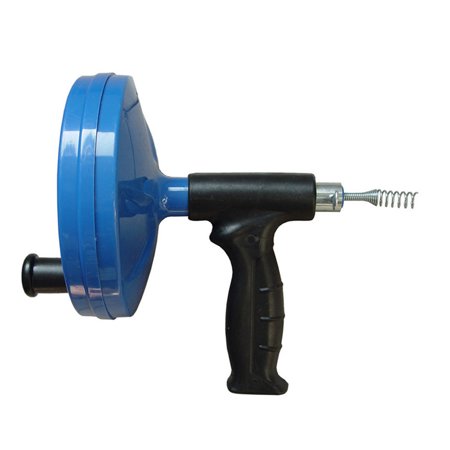
run a bucket cable in the pipe ,,,,,,,,,,,,,,20' ,,,,,,,,,,, 2' is nothing

- Joined
- Sep 28, 2014
- Messages
- 8,578
- Reaction score
- 2,977
get the cable in the pipe then push pull push pull push pull the cable..ROD the pipe
Jeff Handy
Pro Handyman, NOT A Pro Plumber
That’s what my girlfriend tells me!
Back seat driver!
Back seat driver!
So, I found anther old picture from the wall before the drywall was installed. It does not show much, but I can tell that I must have added a horizontal pipe to get it to come out where the vanity would be. (This project has been going on about 5 years, so I don't remember doing that) If the pipe I added was not at an angle, would that be the answer to all of my problems? I probably didn't think about that. If that is the case, is there a way for me to measure the levelness now that the pipe is not exposed? If I determine that is the problem, what are my next steps? I know this could have been a big mistake.
Thanks again.
Thanks again.
Jeff Handy
Pro Handyman, NOT A Pro Plumber
First run a snake in, see if it is blocked or not.
- Joined
- Sep 28, 2014
- Messages
- 8,578
- Reaction score
- 2,977
So, I found anther old picture from the wall before the drywall was installed. It does not show much, but I can tell that I must have added a horizontal pipe to get it to come out where the vanity would be. (This project has been going on about 5 years, so I don't remember doing that)
If the pipe I added was not at an angle, would that be the answer to all of my problems?
yes, It is called back fall or a belly.
the only way to fix it is to remove the cabinet , sheet rock, and remove the pipe
RE INSTALL correctly
NOT what you wanted to hear.
I probably didn't think about that. If that is the case, is there a way for me to measure the levelness now that the pipe is not exposed? If I determine that is the problem, what are my next steps? I know this could have been a big mistake.
A pipe must have a slope. If not. the hair/soap/toothpaste crap will sit in the pipe and not leave
causing a blockage
Thanks again.






